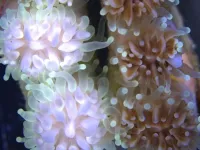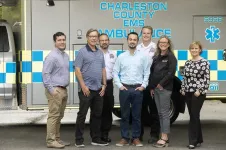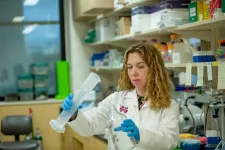Researchers have known about cancer’s blood vessel infiltration for decades, but it was only in the past few years that Stanford Medicine scientists and their colleagues discovered that tumors don’t just tap the body’s highway system; they can also infiltrate and exploit its “telecommunications.”
To put it in physiologic terms, tumors don’t just grow blood vessels; they also wire themselves into the nervous system. Certain brain cancers form working electrical connections with nearby nerves, then use the nerves’ electrical signals for their own purposes, the research has shown. The latest findings, published Nov. 1 in Nature, demonstrate that these tumors can even hijack the biological machinery of brain plasticity — which enables learning — to drive their own growth.
The discoveries have opened a novel field of medicine called cancer neuroscience. It offers new opportunities to target some of the deadliest forms of cancer, including brain tumors that are almost always lethal. Scientists are especially intrigued by the cancer treatment potential of FDA-approved drugs developed for other neurological disorders, such as epilepsy. It turns out that several such medications interrupt neural signals now understood to fuel certain cancers.
“Since 2015, when we first published that neuronal activity actually drives the growth of cancer in multiple brain tumor types, there has been a very exciting explosion of studies on these interactions,” said Michelle Monje, MD, PhD, a professor of neurology and neurological sciences and senior author of the new Nature study, whose team’s discoveries form the foundation of cancer neuroscience. “This is clearly a major set of interactions crucial to tumor biology that we had missed.”
Tumors’ hidden talent
Why did cancer’s ability to twine into the nervous system stay hidden from researchers for so long? A focus on how malignant and healthy cells differ may provide an explanation.
“People tend to think of cancer as more like an infectious disease, something that’s occurring but has nothing really to do with our body,” said Kathryn Taylor, PhD, lead author of the Nature study and a postdoctoral scholar in neurology and neurological sciences. “Whereas really, particularly in pediatric tumors, it’s a developmental disease.”
Small missteps in development underlie some of the worst childhood tumors, Monje’s team has shown.
This is true of one especially horrible type of brain cancer, diffuse intrinsic pontine glioma. Known as a high-grade glioma, DIPG arises in the brainstem that controls essential body functions such as breathing and heartbeat. It entwines with healthy cells, meaning it can’t be removed surgically. The five-year survival rate is 1%.
In 2011, Monje showed that DIPG arises from a type of healthy brain cells called oligodendrocyte precursor cells. Normally, OPCs develop into brain cells that produce insulating myelin, a substance that coats nerves and speeds up their electrical signals. This “neuron maintenance” job requires the healthy cells to stay in close communication with adjacent neurons, receiving and responding to neurons’ electrical and chemical signals.
DIPG cells respond to the same signals, but use them to fuel malignant growth, Monje’s team has demonstrated.
“The cancer is diffusely and widely invading the nervous system because that’s advantageous for it,” Monje said. “It integrates into neural circuits.”
Hardwired into the brain
In 2019, Monje’s team published a groundbreaking study showing that DIPG and similar cancers form working synapses with neurons. Synapses are the nervous-system widgets that allow electrical signals to cross the gaps between one cell and the next. Via these connections and additional means of electrical signaling, about half of all glioma cells in a given tumor have some type of electrical response to signals from healthy neurons, the research showed.
Adjacent brain cells also signal to each other with proteins that cross the space between cells to trigger complex intracellular responses. Such responses include molecular signals that underlie the neural plasticity needed for learning and memory. (The brain physically changes as we learn; these signals are part of that change.)
The new study investigates tumor responses to brain-derived neurotrophic factor, or BDNF, a protein that helps enable brain plasticity. With BDNF, the brain can strengthen synaptic connections between cells, enforcing a neural circuit that’s built as we learn.
The tumors use BDNF the same way healthy brain cells do, the researchers showed: BDNF travels from neurons to tumor cells to trigger a chain reaction inside the tumor that ultimately helps the tumor form more and stronger synapses.
During the studies of BDNF, which Taylor led, one key experiment showed that when the cell machinery triggered by BDNF was activated more strongly, the tumor cells responded with stronger electrical currents, which then fueled their growth. In other words, cancer uses the brain’s learning machinery to grow.
“We looked at the electrophysiological recordings and seeing this increase was … I will never forget that. It was pretty incredible,” Taylor said. “What was so striking about that finding was that not only can the cells connect, they also dynamically respond to input from healthy brain cells. The tumor cell is not only plugging into the network, it’s increasing its connection to that plug.”
Prior research by Monje’s team showed that another mechanism involved in neural plasticity, driven by a signaling molecule called neuroligin 3, works independently of BDNF to also increase neuron-to-glioma synapses.
It’s unsettling that tumors use brain activity to grow, Taylor admits. “It’s the same electrical activity that helps us think, move, feel, touch and see,” she said. “Cancer is plugging into that and using that to grow, invade and even occur in the first place.”
Hope for treatment
But understanding these unsettling interactions between tumors and the healthy nervous system presents new options for cancer treatment.
In the Nature study, Taylor, Monje and their team showed that medications aimed at the BDNF receptor, which were developed for other forms of cancer that have mutations affecting the receptor, work surprisingly well at slowing the growth of DIPG and other gliomas that do not typically have genetic alterations in that receptor.
Other drugs, including certain painkillers, anti-seizure medications and blood pressure medications also have potential as cancer fighters. A detailed understanding of how the tumors tap nerve signals to grow provides a huge leg up in cancer treatment research, as scientists can match what’s in the “medicine cabinet” of FDA-approved neuroactive drugs with their new knowledge of how cancers operate.
Stopping the worst gliomas, including DIPG, will require a mixture of tactics, from cancer neuroscience and from other oncology specialties, Monje said. Perhaps doctors can start treatment with neurological medications that slow the tumors’ growth, then give immunotherapies — such as specially engineered immune cells called CAR-T cells, which her team is also studying as a treatment for DIPG — as a second line of attack. Such a strategy might give immunotherapy treatments enough of a head start to enable them to outpace the rapidly growing tumors.
Monje’s team also plans to learn more about how electrical currents prompt tumor growth. “As we uncover granular details of those voltage-sensitive mechanisms, that will open up a whole additional realm of potential therapeutic targets,” she said.
Cancer neuroscience is also offering clues about how to tackle tumors outside the brain. Nerves normally send signals to stem cells that help regulate healthy organ development and repair, and research is increasingly documenting that these signals can fuel cancer. “There are critically important roles for the nervous system in pancreas, prostate, breast, colon, gastric, skin, and head and neck cancers — a very long list,” Monje said, adding that there’s also evidence that tumors that began outside the nervous system can piggyback on normal nerve signals once they invade the brain.
Hope for the future
For Monje, who was inspired to study DIPG more than 20 years ago, at a time when the biology of the disease was completely unknown, the new options are heartening. The old way of trying to treat the deadly tumor — a sort of throw-the-spaghetti-at-the-wall approach, using drugs not fitted to how the tumor grows — are over, she said.
“This is a connected tumor; it’s connecting to the entire nervous system. We have to disconnect it,” she said. “We understand enough about this disease now to have lots of really rational ways to try to fight it.”
Researchers contributed to the new study from the Weizmann Institute of Science in Rehovot, Israel; Massachusetts General Hospital; Harvard Medical School; and the Broad Institute of the Massachusetts Institute of Technology.
The study was funded by grants from the National Institute of Neurological Disorders and Stroke (grant R01NS092597), the NIH Director’s Pioneer Award (DP1NS111132), the National Cancer Institute (P50CA165962, R01CA258384 and U19CA265404), Abbie’s Army, the Robert J. Kleberg Jr. and Helen C. Kleberg Foundation, the Gatsby Charitable Foundation, Cancer Research UK, Damon Runyon Cancer Research, ChadTough Defeat DIPG, the Stanford Maternal and Child Health Research Institute, N8 Foundation, the McKenna Claire Foundation, the Kyle O’Connell Foundation, the Virginia and D.K. Ludwig Fund for Cancer Research, the Waxman Family Research Fun, and the Will Irwin Research Fund.
# # #
About Stanford Medicine
Stanford Medicine is an integrated academic health system comprising the Stanford School of Medicine and adult and pediatric health care delivery systems. Together, they harness the full potential of biomedicine through collaborative research, education and clinical care for patients. For more information, please visit med.stanford.edu.
END



